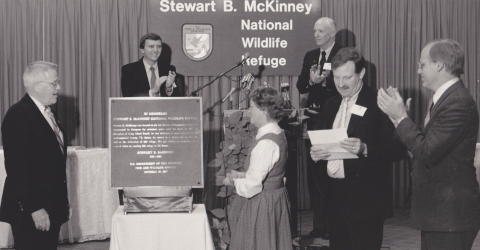About Us
Stewart B. McKinney National Wildlife Refuge is comprised of 10 units stretched across 70 miles of Connecticut's coastline. It was established in 1972 and was originally called Salt Meadow National Wildlife Refuge. The refuge was renamed in 1987 to honor the late U.S. Congressman Stewart B. McKinney, who was instrumental in expanding it.
Located in the Atlantic Flyway, the refuge provides important resting, feeding, and nesting habitat for many species of songbirds, wading birds, shorebirds like the threatened piping plover and seabirds including the endangered roseate tern. The refuge is also home to the threatened northern long-eared bat and many other at-risk species. Overall, the refuge encompasses over 1,000 acres of forest, shrub land, barrier beach, tidal wetland and fragile island habitats.
Many opportunities exist for visitors to explore the diverse habitats of the refuge through the approved recreational activities detailed on other pages of our website.
Our Mission
Vision
The Stewart B. McKinney National Wildlife Refuge will work successfully with the community to conserve quality wildlife habitat while providing a venue for wildlife viewing, wildlife and history interpretation, environmental education, and the traditional pastimes of hunting and photography.
Refuge Purposes Each unit of the National Wildlife Refuge System is established to serve a statutory purpose that targets the conservation of native species dependent on its lands and waters. All activities on those acres are reviewed for compatibility with this statutory purpose. The Congressionally-designated purposes for which Stewart B. McKinney NWR was established (Public Law 98–548, 98 Stat. 2774) are: - To enhance the populations of herons, egrets, terns, and other shore and wading birds within the refuge; - To encourage natural diversity of fish and wildlife species within the refuge; - To provide for the conservation of all fish and wildlife within the refuge; - To fulfill the international treaty obligations of the United States respecting fish and wildlife; and - To provide opportunities for scientific research, environmental education, and fish and wildlife-oriented recreation. Additionally, at the Falkner Island Unit (16 U.S.C. 742f): - “... for the development, advancement, management, conservation, and protection of fish and wildlife resources ...” - “... for the benefit of the United States Fish and Wildlife Service, in performing its activities and services. Such acceptance may be subject to the terms of any restrictive or affirmative covenant, or condition of servitude ...” Additionally, at the Salt Meadow Unit (16 U.S.C. 715d): “… for use as an inviolate sanctuary, or for any other management purpose, for migratory birds.” |
Our History
Key Dates:
1972 – Salt Meadow is established as Connecticut’s first national wildlife refuge national wildlife refuge
A national wildlife refuge is typically a contiguous area of land and water managed by the U.S. Fish and Wildlife Service for the conservation and, where appropriate, restoration of fish, wildlife and plant resources and their habitats for the benefit of present and future generations of Americans.
Learn more about national wildlife refuge , with a donation of 150 acres of land in Westbrook from Miss Esther Everett Lape
1984-85 – A federal law is signed that creates the Connecticut Coastal National Wildlife Refuge and the Chimon Island, Sheffield Island, Goose Island, Falkner Island and Milford Point Units are added to the refuge system shortly after
1987 – Congressman Stewart B. McKinney - who had worked hard to get the Connecticut Coastal National Wildlife Refuge established - dies; Congress renames the refuge in his honor
1990 – The Connecticut Coastal Protection Act authorizes the acquisition of more land for the refuge, including Great Meadows in Stratford, which is added within a few years; the act declares that the Salt Meadow NWR and all refuge lands in the vicinity of Long Island Sound become part of the Stewart B. McKinney NWR
1995 - Elizabeth Hird, architect and owner of Outer Island in the Thimbles of Branford, donates her island to become part of the refuge so that it can be used for education and Long Island Sound research.
Early 2000s – Calf Island (Greenwich), Peach Island (Norwalk) and Menunketesuck Island (Westbrook) all become part of the refuge
2013 – The New Haven Harbor Watershed Urban Wildlife Refuge is established – refuge staff begin working with many partners in urban areas around the city to do habitat restoration, environmental education and other community projects.




